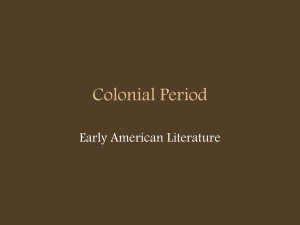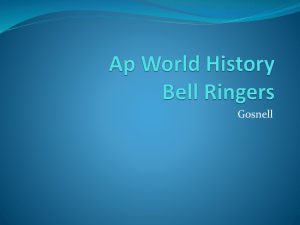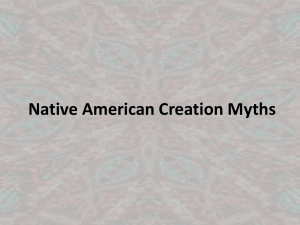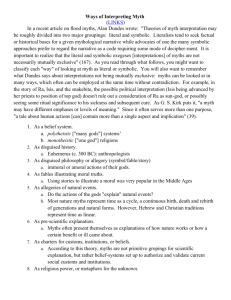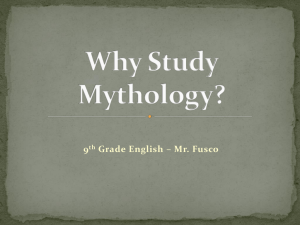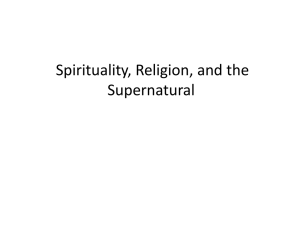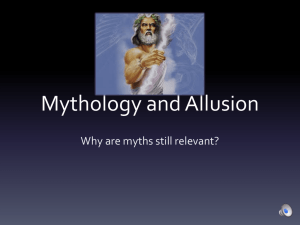Origin Myths and Early Colonial Literature
advertisement
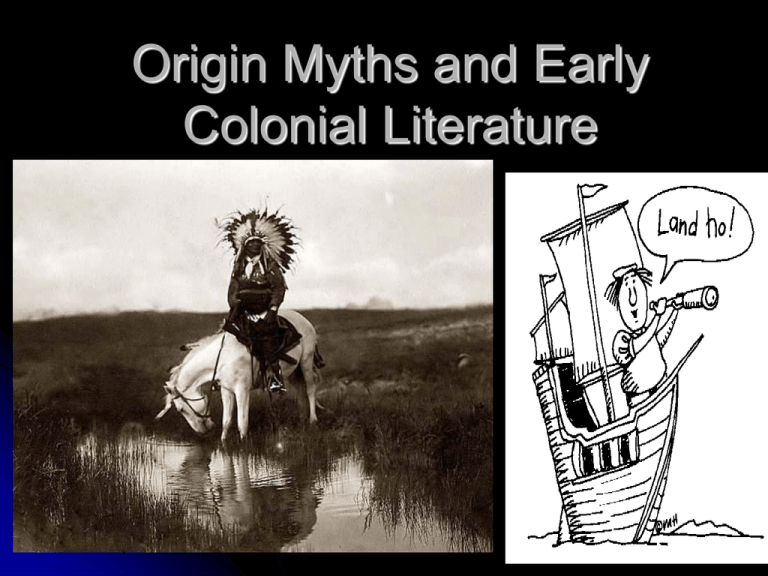
Origin Myths and Early Colonial Literature Colonial American Literature Native American Literature Literature of Exploration - Virginia Northern Colonies Southern & Middle Colonies The first people… Native Americans immigrated over the land bridge from Asia in 35,000 BC The first Europeans enter North America in 1600’s. The last colonies were settled in 1732 Native American Literature: Creation Myths Myth A traditional story, passed down through generations, that explains why the world is the way it is. Events usually result from the actions of supernatural beings. Myths Contain supernatural elements Often explain the unexplainable Have also been told in order to teach a moral lesson. All cultures have myths, though often do not see their stories myth but as fact. Oral tradition Native American myths originated as oral tradition: stories passed down verbally Oral Tradition. . . Native American creation myths were not written down until just a few hundred years ago. It was passed down by storytelling and performances. Examples: lullabies, bedtime stories. Four functions of myth: 1. To awaken us to the mystery and wonder of creation 2. To explain the workings of the natural world: every corner, every rock, hill, stone, and flower has its place and its meaning. 3. To pass down the moral and ethical codes that support and validate social customs. 4. To teach: to guide the people through the trials of living Creation myths Explain how the universe, the earth, and life on earth began. Quick Write What different accounts of creation- biblical, scientific or stories from family or other cultures have you heard or read? Write a brief response to what you believe and how you came to know it… Essentials of Creation Myths Creation Myths… 1. To instill awe 2. Explain the workings of the natural world 3. To support customs 4. Guide people through the trials of living Trickster Tales Trickster- some one is creative curious and often gets into trouble. Will sometimes find wisdom through their curiosity. More About Native American Literature Oral Traditions Integration of the natural world with the human world No separation of spiritual and physical Importance of ancestors Trixter figure – often a coyote Rich literary tradition – developed mythology Extremely diverse Native American legacy today – Sherman Alexie Native American Literature The Lesson of the Birds The Earth on Turtle’s Back The Fox, Coyote, & Whale Colonial Period The first migration to the Americas was not by the British. The first migration occurred 20 – 40,000 years ago when Ice Age Hunters traveled from Siberia to Alaska. Slowly these people and their descendents migrated south. When European exploration began, these were the people who were living in the “New World.” In 1492, Columbus “discovered” America. Taking Native Americans with him to Spain, stories began to circulate about the wonders of the New World, about its exoticism and bountifulness. Spanish and French explorers wrote about this new world in over-exaggerated styles, praising its beauty, making it appear as Al Dorado (the place of hopes and dreams). America was viewed as the land of plenty, the land of peace and hospitality, the land of riches This brought hope for those who were being prosecuted across the world. When Europeans began voyaging to this world, they unleashed diseases such as smallpox, measles, typhus, and so on, on the Natives, who were also enslaved and mistreated. In the face of this, Native American population began to decline rapidly, and thus, Spain introduced African slavery in 1501 The period of European exploration brought with it a huge body of literature that is referred to as a literature of witness or exploration narratives The early settlers brought with them their knowledge of written communication with its particular style and content. They wrote about their new experiences in forms that were familiar to them – letters, factual records, sermons, and poems. Captain John Smith: A Description of New England (1616) The Landing of the Pilgrims, 1620, relief by Enrico Causici on doors of U.S.Capitol Rotunda (1825) Remember: This passage to the New World was filled with memories of the violence of the old country and the fear of the unknown terrors of the new one: the loss of home, of kinship (relationships, connections), of worldly possessions, of cultural and personal identity Exploration Literature Captain John Smith: The General History of Virginia, New England, and the Summer Isles (1624) The Generall Historie is Smith’s most comprehensive discussion of conquest and exploration and stands today as an exemplary text in the exploration literature of the 16th and 17th century William Bradford: Of Plymouth Plantation (1650): a journal comprising the story of the Pilgrims and the early years of the founding of their colony (from 1608 to 1647) Christopher Columbus: From Journal of the First Voyage to America (1492): a journal written nine days after Columbus Arrived in the Americas Pocahontas Your Homework tonight Directions: Write an origin myth that is at least one page typed (Double Spaced), 1” margins, 12 pt. Font) or two pages (front and back written) Your myth must include the following elements: Explain the origin of a phenomenon in nature (refer to examples discussed in class) Creation of man, animals, or the earth Must include an Immortal Being

